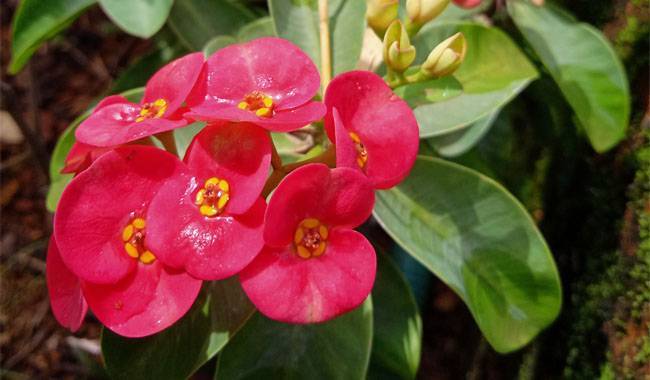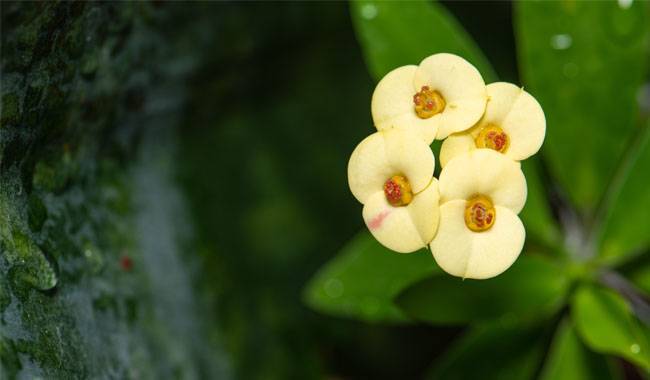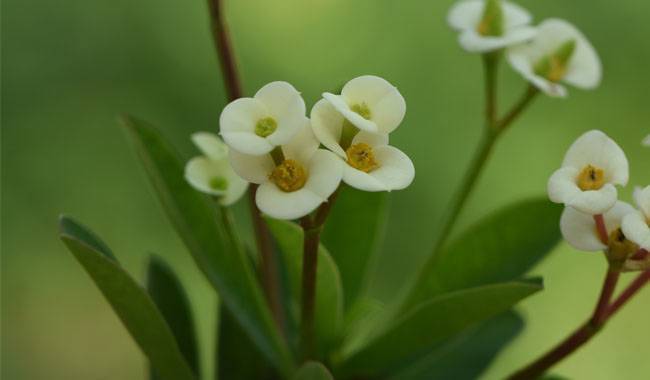
Today’s flower market is awash with a stunning array of Euphorbia lophogona species, both for the garden and indoor cultivation. But unfortunately, new and often erratic species are replacing older species that are firmly rooted. Just half a century ago, they were on the windowsills of almost every home and institution. One of them was crowned or ribbed in shape. Despite being somewhat “forgotten,” this plant deserves special attention. If only because it has an uncommon appearance and requires simple (even for beginners) care. You will learn how to grow Euphorbia lophogona plants in ThumbGarden’s article.
Euphorbia lophogona is native to Madagascar and is a rather large stalked fleshy shrub that reaches a height of 47 inches (1.2 m). It is found in tropical and subtropical coastal forests, where it prefers sandy areas.
As its name suggests, it is distinguished from other Euphorbia lophogona plants by the unusual shape of its trunk, which has five faces, or peculiar ribs with gray scars, topped by a bunch of bright green, long oval leaves. At first glance, it looks like a palm tree with an angular trunk. However, it has nothing in common with a palm tree.
The stem of Euphorbia lophogona is usually unbranched or has only a few branches. It thins at the top and twists into a spiral shape. Each edge has some spines. The leaves are fleshy, glossy, and decorated with white veins; the middle veins are convex. They are located at the top of the stem. The flowers are in yellow-green inflorescences surrounded by white or pink bracts.
They bloom in summer as early as the first year if the conditions are good indoors (when propagated from cuttings, and the second year when propagated from seed). The flowers form at the top of the stem, and after flowering, the plant reproduces itself from seeds, generously dispersing them within 50 inches (1 m) of itself.
GROWING CONDITIONS OF EUPHORBIA LOPHOGONA

As mentioned above, in nature Euphorbia lophogona prefers poor, sandy soil. Therefore, you can grow it at home in the same soil used for cacti and succulents. You can buy it at retail stores or florists, or you can make your own by mixing equal amounts of sand, peat, and potting soil.
Young seedlings are best planted in small pots. Then, as they grow, every two or three years in the spring, transplant them into a larger container without traumatizing the root system. Form a drainage layer in the bottom of the pot, which can be made of expanded clay or small river pebbles. Add a handful of charcoal on top – Euphorbia lophogona does not like stagnant moisture in the roots, and such a “pillow” will prevent it from rotting.
This plant is best in a sunny spot, but with diffused light – in open sunlight, Euphorbia lophogona’s leaves will burn, and the trunk will have coarse brown spots. Therefore, an eastern or western window is best for it.
However, insufficient light also affects Euphorbia lophogona. Its stems become elongated, and the leaves become small, the plant loses its attractiveness, and ages rapidly. Therefore, in the conditions of a north-facing window, it is recommended to shine extra light on it.
Milk Euphorbia lophogona also does not like extreme temperatures. In the summer, the comfortable temperature range is 68-77 °F (20-25 ° C). In winter, the temperature is lower, but not below 60 °F (16 ° C). Lower winter temperatures ensure that Euphorbia lophogona slows down its growth process, which positively impacts its ornamental qualities – it does not stretch out in the absence of light in winter.
CARING FOR EUPHORBIA LOPHOGONA PLANTS
The comb of Euphorbia lophogona is well adapted to dry air. Therefore, you can safely keep it outside in the summer. However, it is also good to remember to spray the neighboring plants, and it is good for it to spray infrequently.
Water Euphorbia lophogona plants properly. Although the plant does not like stagnant water, it should be watered liberally in spring and summer with warm, still water at room temperature. The amount of water is easy to calculate, as long as there is enough water to get a little extra water out of the hole in the pot. You should let the soil in the pot dry out between waterings.
In autumn you should reduce the amount of watering. The closer you get to winter, the more the temperature drops, the less watering you should do. In spring, as the temperature rises, the amount of water and watering frequency will increase again.
To stimulate Euphorbia lophogona in the spring, it should be fertilized weekly with cactus and succulent fertilizer during the summer and until mid-autumn. Alternatively, use a common indoor flower fertilizer with a higher phosphorus and potassium content but in a highly diluted form.
The older Euphorbia lophogona gets, the taller it gets. For this reason, it is recommended to tie it to a stand. In this way, it will be subjected to less stress and will not break during repositioning.

PROPAGATION OF EUPHORBIA LOPHOGONA
Euphorbia lophogona can be propagated not only by seeds, but also by cuttings. In addition, as already mentioned, the plant disperses seeds independently and germin actively in all surrounding pots.
To propagate Euphorbia lophogona, collect the seeds and sow them in a light potting soil, moisten the soil with a sprayer and cover the pot with film or glass. The seedlings will germinate quickly. The seedlings should then be planted in their pots and cared for in the same way as adult plants.
Propagation from cuttings is more problematic, as molokais rarely and reluctantly stick their branches. If you cut off the crown, the ornamental nature of the plant is lost. Therefore, if you can separate cuttings, you should do it in late spring or summer. The cuttings should be left to dry for a few days (2-3 days). Only then can it be planted in the soil.
Do the same with the cuttings, but let the milky sap runoff and cover the cuttings with crushed charcoal or cinnamon. Handle the plugs with care, as Euphorbia lophogona is toxic and can cause skin irritation and even burns.
PROBLEMS RELATED TO THE CULTIVATION OF EUPHORBIA LOPHOGONA
Sometimes Euphorbia lophogona begins to lose its ornamental value, and then the question arises: how to help the plant? The answer is simple – to level out the growing conditions.
If the leaves droop and fall off, it indicates a lack of water. The rate and frequency of watering should be increased.
If the leaves turn yellow before dropping, this is a sign of overwatering or temperature fluctuations. The amount and frequency of watering should be reduced and drafts avoided.
Smaller leaves and thick trunk – lack of light can cause this problem. If this is the case, Euphorbia lophogona should be placed in a brighter place or additional light provided. In winter, the temperature can drop to about 60 °F (16 °C).
Spots appear on the leaves and the trunk becomes rough and covered with a black crust – these are sunburns. In this case, the plant should be shaded or moved to diffused light.
Euphorbia lophogona also does not like dense plant spacing. If there is too much water, white powdery spots, known as powdery mildew, may form on the plants. Therefore, plants should be placed so that there is space around them for air circulation and so that excess water that forms after watering evaporates in a timely manner.







